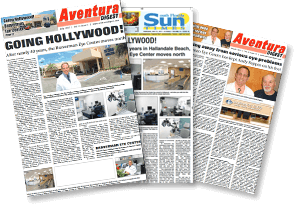LASIK Using Allegretto Wave Eye-Q 400 in South Florida
Are you interested in learning more about Allegretto Wave Eye-Q 400 technology? The Braverman Eye Center, a leading South Florida LASIK provider in Hallandale Beach, Florida offers this exciting vision correction option to patients throughout South Florida. See below for additional information:
Visual Acuity
There's more to good vision than "20/20".
If you're reading this, you're probably familiar with the vision chart that hangs in every optometrist's examining room--the one with a big "E" at the top. It's officially known as a Snellen chart and has been the basis for measuring what's known as visual acuity since the late 1800s. Think of visual acuity as a quantitative measure of your vision, establishing where your vision is placed on a numeric scale. There are also qualitative measures of your vision, such as your ability to perceive subtle contrast changes, especially in low-light situations. Taken together, these quantitative and qualitative measures determine the overall performance of your vision.
Visual acuity: your vision, by the numbers.
If your visual acuity is determined to be 20/20, you see at 20 feet what a person with normal vision sees at 20 feet. If you have 20/40 vision, you see at 20 feet what a person with 20/20 vision would see at 40 feet. And, if you're one of the lucky ones (e.g., 20/15), you can see at 20 feet what others would have to move closer (15 feet) to see. Your visual acuity is an important measure of your vision. Many common problems can be identified by this measurement method, including the ones you've most likely heard of before - like nearsightedness and farsightedness.
Beyond the numbers: your vision quality
There are also qualitative factors affecting your vision. A number of considerations - like contrast sensitivity - also contribute to your vision's performance. Contrast sensitivity is a measure of the ability to discern subtle changes in a visual image. Many routine visual tasks - recognizing a face, for example - rely more upon contrast sensitivity than visual acuity. Problems believed to be associated with poor visual quality are normally most apparent in low-light situations.
Understanding your vision requires taking both the quantitative and qualitative measures into consideration. This is because it's possible to possess very good visual acuity yet have poor visual quality, and vice versa. It's important to consider both as you make your decision about laser vision correction.
Low Light Vision Problems
In addition to those vision problems you've probably heard of before - the lower order aberrations like nearsightedness and farsightedness - there are common vision problems known as higher order aberrations that can also affect your vision. Higher order aberrations are widely believed by ophthalmic experts to contribute to common night vision problems, including glare and halos.
Higher order aberrations cannot be corrected through traditional LASIK procedures. Similarly, glasses and contact lenses are unable to help with these vision problems. An exciting new procedure called CustomCornea® Wavefront-Optimized treatment is the first laser vision procedure that's capable of correcting both lower order and higher order aberrations.
Diagnosing higher order aberrations
Higher order aberrations are diagnosed and measured using wavefront maps. These maps are plotted by passing a narrow ray of eye-safe light through the optical system and measuring the optical distortions as the light exits the eye. These patterns are then compared with the flat wavefront associated with normal vision. An ideal wavefront map would be perfectly flat.
About The Braverman Eye Center
The surgeons of Braverman Eye Center are well-known as South Florida, Ft. Lauderdale and LASIK Miami specialists. These renowned surgeons have also helped many / Cataracts Fort Lauderdale patients achieve remarkably clear vision.





